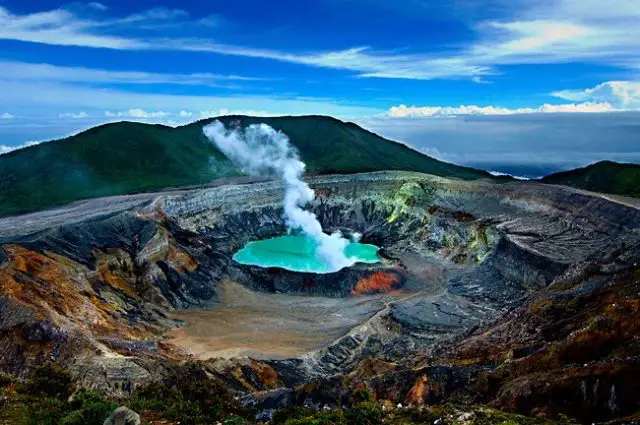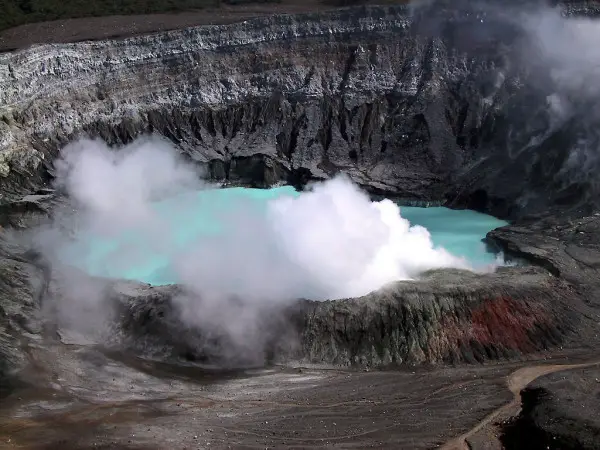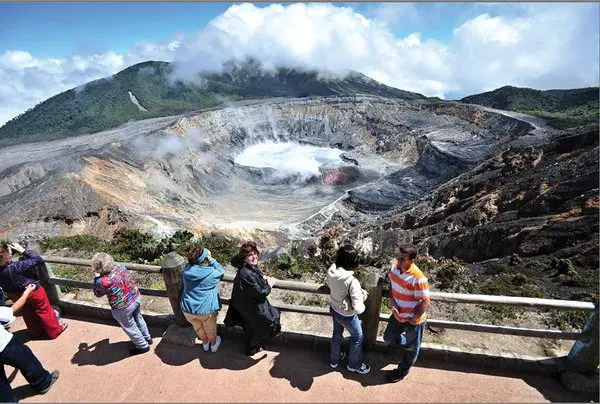
Those tourists who seek to encounter volcanoes firsthand and up-close should come to Costa Rica as their main destination worldwide for this experience. Costa Rica has an incredible variety, due in large part to its geographical position between the continents of North and South America, its neotropical climate and its wide variety of habitats.
Volcán Poás National Park is located just 30 minutes from San José, in the province of Alajuela. Poás is one of the largest and most active volcanoes in the country. It has one of the most acidic lakes on earth, which frequently presents changes in color in a matter of hours – from emerald green to a grayish-white.
Established as a national park on January 25, 1971, its main attraction is the Póas volcano, a complex and very active stratovolcano that reaches 2708 meters above sea level, being one of the highest peaks of the country. It is considered one of the natural wonders of the country. In turn, the park is the most visited nationwide with a visitor center, basic services, and trails.
The volcanic massif of Poás is composed of three craters: Main (active), Von Frantzius (by Alexander von Frantzius, German doctor and explorer) and Botos (about the natives who lived in the area). The main crater is 300 m deep and approximately 1.32 km in diameter in a north-south direction, which makes it the largest geyser crater in the world and one of the largest craters in the world.

It is still active today, with small gas emissions and an acid lagoon. The last major eruptions were in 1952, 1954, and 2014 and in April 2017, this last eruption caused the park to be closed indefinitely for safety, until it was authorized to re-open in August 2018. Geologically, the Poás Volcano National Park has a complex geological structure that includes the Congo volcano, the Hule lagoon, and the Río Cuarto lagoon, in addition to the territory of the Poás volcano itself, formed about 40,000 years ago.
The main crater, the only one that shows volcanic activity, has a semicircular shape, with a north-south diameter of 1,320 m and a depth of 300 m between the viewpoint (2,560 msmn) and the lagoon. To the south, the bottom of the crater It has lacustrine and pyroclastic deposits. The crater has morphogenetic units: the eastern plateau, the lagoon, the lava dome, and the esplanade. This crater has a lagoon with very acid and hot waters, which measures 300 m in diameter and 40 m deep. The crater walls have strong slopes. In the southern part, it has gullies and ravines. Several semicircular contours inside this crater indicate the existence of ancient craters now deformed by volcanic and erosive processes.
In 1747, the then governor of Costa Rica Juan Gemir registered the name of the volcano as Los Botos Volcano. This indigenous tribe inhabited the skirts of the mountain since the time before the Conquest, and there are even legends of human sacrifices in the crater to placate the god of the volcano. Then only the Crater Lake maintained this name while the Volcano was known at Poás.
In the northern part, due to the erosive effect, a complete sequence of stratified eruptive products of several millennia can be observed, which reveals the geological history of the volcano. A series of natural pipes simulate sculpted gargoyles, giving the inner walls of the crater a winter, gloomy and / or dantesque appearance.

In the eastern part, there are several volcanic terraces of varying thickness product of old lava flows. The eastern plateau is a large terrace 500 m long, supported by a solidified lava base 30 m thick, and located 100 m high on the bottom of the crater. The crater lagoon is of thermo-mineral type, with a pH level of practically 0, making it one of the most acidic natural lagoons in the world. Due to the intense eruptive activity of 2017, this lagoon evaporated, leaving only a water mirror in the northern sector. Due to the volcanic activity, in July 2017 the Crater Lake disappeared in its entirety, but at the beginning of 2018, due to the intense rains that occurred and the closure of ducts, the lake reappeared in the Von Frantzius crater.

LOOKING FOR A PLACE TO STAY? Checkout this cool AirBnB location near the city and this Volcan Poas National Park: CLICK HERE
